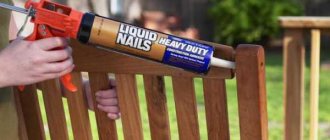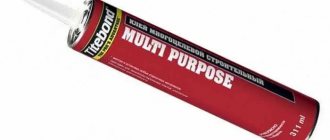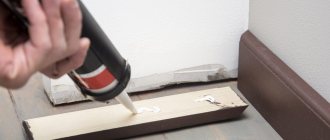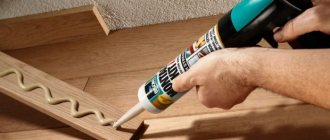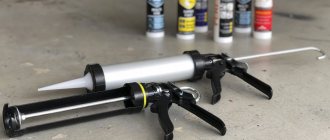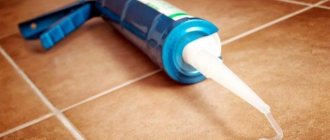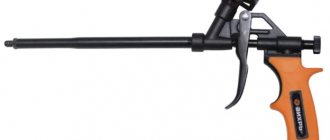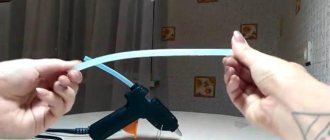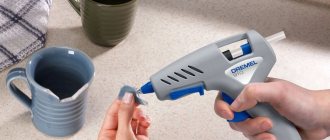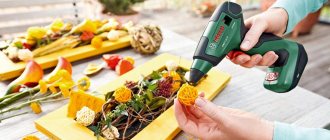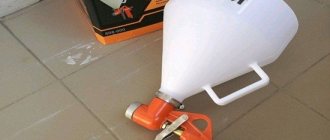Description of the device operation process
First you need to figure out how to properly place the container with “liquid nails”.
It is unacceptable that the seal of the package is broken if installed incorrectly, otherwise the glue will dry out and it will hardly be possible to use it. Before using the gun, you need to prepare the following things:
- a bottle of “liquid nails”;
- sharpened knife;
- glasses and gloves for protection;
- a breathing mask if you plan to use an adhesive mixture prepared yourself;
- a dry rag to remove excess adhesive;
- a solvent, due to the fact that the glue may accidentally get on the skin or some surface.
The principle of operation of the tool is quite simple - after pressure is applied to the cylinder mechanically, the adhesive substance “comes out” of the cylinder. The pressure is provided by a rod, which is activated by acting on the trigger lever. In pneumatic mounting units, pressure is supplied by air. Difficulties arise when you need to choose the appropriate glue. As a rule, manufacturers use the same standards, that is, glue can be selected for any gun.
If you use a skeleton or semi-open pistol, removing blockages occurs quite quickly. First, check to see if the container with “liquid nails” has a special restrictive bottom. If it is there, delete it.
Next, pull the rod out of the device; to do this, mechanically act on the lever and remove the rod. Instead, install the tube and press the release lever 2-3 times with little force to strengthen the balloon.
Poke a hole in the container, glue will flow through it to the tip.
If you decide to use a tubular tool, it is charged differently. First you need to make a hole in a container with “liquid nails”. The container with the adhesive must be fixed so that the cut end of the container is directed towards the tip from where the glue will “come out”. Before installing the cartridge into the tool, you must remove the rod.
As a rule, the kit comes with several nozzles with tips; use one of them to tighten the cylinder. If there is no hole on the tip, then you need to cut off a very small part with a knife at an angle of 45 degrees. Then gently press the trigger lever and move the glue along the pre-applied markings. If you use a skeletal or semi-open instrument, then in order to fill the void in the cap, you must first press the trigger lever several times, and then perform the actions smoothly.
In electric and battery-powered mechanisms, pressing the release lever controls the rate of release of the adhesive substance, so if you have never used such a complex unit before, it is better to start with inconspicuous places.
Before the gluing procedure, the surfaces must be cleaned and degreased. Then apply “liquid nails” in a thin layer or in dots. If the surfaces to be glued have a large area, for example, ceramic tiles, then it is necessary to apply the adhesive on them in the form of a snake or mesh. Afterwards, the surfaces to be glued need to be pressed against each other; if necessary, they should be fixed with special structures. Flat parts can be placed under the press. Some types of glue set within 1-2 minutes.
As a rule, complete gluing of surfaces occurs after 12 hours, sometimes after a day.
Types of pistols
Guns come in both manual (you have to force yourself to push the rod forward) and automatic (they are much easier to use and are ideal for professionals who need to apply sealant to a large area).
It is necessary to take a closer look at each of the available types of pistols. This useful information will help you understand the advantages and disadvantages of each known type and which one is right for you.
Mechanical manual
This is the simplest, cheapest and most reliable pistol (provided that it is made of high-quality metal or aluminum alloy). It was his design that was taken as a basis above.
The open frame allows you to easily load the tube into the gun. At its end there is a special cutout for the packaging attachment, which ensures stable fixation. Such pistols are of standard size and are designed on average for a tube with a volume of 350–500 ml. They are great for household needs because:
- have a balanced design and moderate weight;
- allow you to fully control the process of squeezing out the sealant;
- suitable for reusable use.
Such a gun is unlikely to be useful to qualified craftsmen who constantly use sealant in their work. But if you are a hobbyist and one tube lasts you 6-12 months, then it will be an excellent choice.
Pneumatic
As the name suggests, this gun moves the rod using compressed air supplied from the compressor through a flexible hose. The undeniable advantage of the model is the constant pressure on the bottom of the sealant and the absence of strain on the hands. It is enough to press the lever once, after which the product will be supplied through the nozzle continuously.
This gun is great for experienced builders. Once you get used to it, you can make a smooth and uniform seam of great length. Some models are equipped with a special excess discharge system, which ensures precise consumption of sealant and reduces costs.
The disadvantage of such a gun is that it is tied to a compressor, which limits mobility. Due to this, this model is suitable for working in certain areas.
Rechargeable
This tool has the advantages of an air pistol, but at the same time allows the master to maintain mobility. Due to their high cost, cordless pistols are used mostly by experienced builders and remodelers.
This tool is powered by a lithium-ion battery, the capacity of which is sufficient for several hours of operation.
Electrical
The model is similar to the battery model, but in this case the gun does not have its own storage elements, and therefore requires connection to a household electrical outlet. Plus - it works continuously and for a long time without requiring recharging. The downside is that when using it, you need to take into account the length of the cord or use extension cords, which limits mobility.
Sequence of gluing parts
To release the glue from the tube, you need to press the gun handle with frequent hand movements.
The threaded head of the tube is cut off with a sharp knife or the membrane is pierced with a sharp object. A conical tip is screwed onto the head and the cap is removed from it. The edge of the tip is cut at an angle of 45°, and the cap is put on again. The glue cartridge is ready for use.
Before inserting the cartridge into the gun, the operating rod must be relaxed. The tube is inserted into the device; by pressing the trigger, the rod is clamped until it stops. The cap is removed. By frequently pressing the handle, the glue is applied to the surface in an even strip or dotted fragments. To glue large surfaces, a mesh or snake is applied.
The surfaces to be glued are pressed and, if necessary, fixed with additional devices. Individual flat parts can be pressed down with a press. Some types of glue set within 1-2 minutes.
The total bonding time of the parts is usually 12-24 hours.
The area of surfaces prepared for gluing should be taken into account. Do not completely cover large surfaces to be glued with glue and do not apply excess glue. This will increase the setting time of the composition. To glue decorative parts, the cut is made with the smallest distance from the end of the cone.
Excess glue that appears is wiped off with a rag soaked in solvent. Glue stains remaining on wood parts can be washed off with a special cleaner. The glued structure can be used no earlier than after 24 hours.
How to clean the surface
The procedure for removing excess or residues of liquid gas has several solutions and depends on the time of application and the material on the surface of which it is applied. Let's list the main ones:
- Fresh residues can be removed with a sponge and warm water (or mineral solvent);
- Dried adhesive can be removed with a special cleaner. It is sold in hardware stores;
- If cleaner is not available, a scraper or blade can be used, although this is not suitable for all surfaces;
- Another option for dried glue is increasing the temperature. Since liquid gas generators are operated at a temperature (as a rule) of no more than 50°C, then when heated to 55-65°C, the composition goes into a semi-liquid state and is removed with a scraper;
- An exotic option for old glue is exposure to direct sunlight. Again, we use the “weak points” indicated in the instructions. Staying under the rays softens the liquid gas, subsequently mechanical cleansing with washing is carried out (see the first option).
In general, liquid nails are an effective “lifesaver” for small household repairs. The photo above shows my personal choice. This glue from the company Macroflex has proven itself amazingly in many repair work, especially since it has a very affordable price. Don't take this as an advertisement, take my word for it, I know what I'm saying. I will end here. I hope it was informative... Subscribe to the blog, introduce friends and comment on articles. Hearing an outsider's opinion is always useful...
An anecdote on the topic: Few people know that in the Moment glue production workshop there is always a rosy and positive atmosphere.
Good luck to you in your family affairs and, of course, in construction! Bye!
Wisdom Quote: If all men thought alike, no one would gamble at the races (Mark Twain).
https://youtube.com/watch?v=3GI61aTm67Y
Which liquid nails are best to use: advantages of Titebond
Glue has become an indispensable assistant in repair and construction work of varying complexity. It allows you to glue elements made of stone, concrete, metal, wood. Liquid nails are applied to various surfaces.
The greatest effectiveness of glue is achieved by using the appropriate brand for a particular situation. The instructions describe in detail the areas of application of the products. But among the large number of species, common characteristics are distinguished:
- Practicality and ease of use. People who do not have the skills to carry out repair and construction work will be able to use “Titebond”;
- Applying material to uneven surfaces. In this case, the load is distributed evenly along the entire perimeter. This reduces the pressure exerted on the bonding site;
- Construction adhesive remains flexible after drying;
- Titebond liquid nails withstand vibration and are resistant to deformation;
- Retain properties for many years. Construction adhesive is resistant to temperature changes and chemical influences - acids, alkalis, salts.
Product Features and Applications
Liquid nails are a construction and installation adhesive based on polymers and synthetic rubbers, which allows you to fasten materials of different structures, providing a high degree of adhesion (adhesion) of surfaces. The product is produced under several brands. The composition and properties of specific products may vary. In any case, manufacturers claim that the glue can withstand loads of up to 90 kg/cm². The product is sold in cartridge tubes with a volume of 0.3 liters or more.
The basic composition of liquid nails includes synthetic rubber, polymers and fine filler. It is the presence of the last component that distinguishes this glue from the rest. It allows you to firmly connect surfaces that do not fit tightly.
In the classic version of Liquid Nails, Texas clay, which has increased plasticity, is used as a fine-grained filler. Many manufacturers replace it with chalk (calcium carbonate), but its adhesive properties are worse.
An important point that you should pay attention to when choosing glue is the absence of toluene and acetone in the composition. The first component improves the adhesion characteristics of the product, and the second accelerates drying
But they are toxins for humans. A sign of their presence is a sharp, suffocating smell.
The main areas of use of liquid nails are fixation of various materials:
- ceramic tiles;
- cork panels;
- plastic;
- drywall;
- wood;
- aluminum, teflon;
- glass, mirrors;
- ceramics;
- chipboard, OSB, fiberboard;
- polyethylene;
- polystyrene foam;
- concrete, gas and foam blocks, bricks;
- heavy wallpaper on a natural basis and so on.
In addition, the adhesive can be used to seal seams and cracks in bathrooms, window and door openings, walls, furniture and so on. But its effectiveness compared to special sealants is questionable.
Considering the relatively high cost of liquid nails, it is not advisable to use them for connecting large structures. For example, you should not use it to tile the entire bathroom. But gluing individual parts is quite reasonable.
Best Mechanical Caulk and Glue Guns
The silicone gun is widely used in the construction industry, as well as in car services. A good gun ensures that the sealant is completely used without leaving any residue in the tube, and also makes the extrusion process as simple as possible and helps achieve the desired stripe width. Mechanical models are inexpensive, but they will have to be operated manually.
The ranking of the best mechanical sealants includes:
Bartex G-280/MX-638A
This pistol model has a semi-open metal body and a smooth rod. The plastic handle is located in the center, thereby reducing the load on the hand. To get started, you need to cut off the tip of the cartridge and insert the container at an angle of 45 degrees into the special compartment. The piston pressure forces out a certain amount of material. It is great for small construction work. The pistol has a simple design that even beginners can handle.
| Characteristic | Meaning |
| Construction type | half-hull |
| Rod cross-section, mm | 6 |
| Stock | smooth |
Pros:
- no rod distortions;
- reliable materials;
- does not play;
- high-quality construction;
- ease of use.
Minuses:
- body weight;
- suitable for special capsules with sealant.
Reviews: “Quite a strong and reliable pistol. Withstood a load of 4 sealants. Previously I used other, cheaper analogues, which quickly broke down. I’m very glad that I settled on this particular model.”
STAYER 0673-60
Mechanical device of a German brand. The sealant gun holds a 600 ml tube. The closed mechanism does not bend or move during operation. The mounting loop allows you to free your hands. The lever located on the left side of the device releases the pressure. The aluminum body reduces the weight of the product. Capsules with material are placed in a closed case, which protect hands from contact with sealant.
| Characteristic | Meaning |
| Construction type | closed |
| Rod cross-section, mm | 8 |
| Stock | round |
Pros:
- the rod has anti-corrosion coating;
- lightweight design;
- high performance;
- ease of use;
- practical.
Minuses:
- inconvenient lever;
- sealant is difficult to apply.
Review: “The best closed-type sealant gun. The aluminum body reduces the weight of the tool. The tube is tightly clamped and secured with a nut, and can withstand any load. I’ve been using the device for more than a year, I’ve used more than one tube.”
FOME FLEX Black Edition professional
An improved model of a mechanical pistol. The body is Teflon coated and has an ergonomic handle. The metal surfaces are of high quality, the foam does not stick to the gun, which guarantees the longevity of the device. The spout is made of brass. The design is easy to disassemble for cleaning and is also easy to fold. The model is designed according to customer requirements: the hands do not become overstrained after prolonged work. Equipped with a precise material feeding mechanism.
| Characteristic | Meaning |
| Construction type | Teflon open mechanism |
| Rod cross-section, mm | 7 |
| Stock | chromium-plated |
Pros:
- stainless cleaning rod;
- anti-drip system;
- comfortable handle;
- plastic trim on the trigger;
- equipment;
Minuses:
- if dropped, the plastic casing may break;
- productivity gradually decreases.
Reviews: “I use the product all the time. Tile adhesive and grout are squeezed out well. After use it is easy to clean with a sponge - it is better to wash it immediately after use so that the device can serve for many years. The entire repair took no more than an hour.”
Sparta 886485
The sealant gun is made in an aluminum body. The rod can be easily moved; its surface is additionally sanded and coated with zinc to prevent moisture. The one-piece design keeps the tool stable. The length of the housing is suitable for installing industrial capsules or cartridges. It is quite lightweight, which is optimal for sealing seams on outstretched arms. Suspended from mounting hole or hook.
| Characteristic | Meaning |
| Construction type | closed |
| Rod cross-section, mm | 8 |
| Stock | chromium-plated |
Pros:
- smooth rod;
- holds 600 ml of sealant;
- multifunctional;
- durable body;
- convenient design;
Minuses:
- not suitable for working in narrow spaces;
- When the tube is full, the long rod at the back gets in the way.
Reviews: “I just picked it up from the post office and I’m already delighted. The plastic is very thick and high quality. The handle is ergonomic, with rubberized inserts. It is immediately clear that no problems should arise during operation. I'm happy with the choice."
Kraftool 06677
A branded tool that is used in construction work. It has the shape of a syringe, which comes with additional attachments. The gun greatly facilitates the work of applying mixtures to surfaces of any complexity. It distributes the material evenly throughout the entire thickness. Chrome plated handle prevents corrosion. The case is made of modern plastic, the mechanism is made of metal. The model is distinguished by high build quality and durability.
| Characteristic | Meaning |
| Construction type | closed |
| Rod cross-section, mm | 7 |
| Stock | round |
Pros:
- hard case;
- ergonomic handle;
- comfortable trigger;
- The narrow spout allows you to accurately seal thin seams;
- easy to understand.
Minuses:
- body weight;
- a long cleaning rod is not very convenient to insert into a completely filled tube.
Reviews: “A good, light and strong pistol. I took it specifically to reduce the risk of damage after a fall. A comfortable strap allows you to keep it close at hand without straining your arm muscles. He does everything very quickly and easily.”
How to open liquid nails
Let's start with how to properly open a container with an adhesive composition. The formulations can be sold in aluminum cylinders that resemble cream or toothpaste, ranging from 300 to 900 ml. The mounting component is also squeezed out of such packaging manually.
There is a variety of packaging in special tubes made of thick cardboard or plastic. This type of packaging comes with a dispenser cone.
To use the adhesive:
- If the tube with liquid nails is made of cardboard, a cone is already attached to its top. In this case, you only need to cut off its edge at an angle of 45⁰. The farther from the edge the cut is, the wider the glue line will be.
- If the tube is made of plastic, first make a hole in the top of it. Then put on, secure the dispenser cone and cut off its top, as in the previous point.
Liquid nails - selection rules, instructions, scope - Repair and construction
In our time, the term “liquid nails” has not been heard only by those who never do anything at home with their own hands.
And, moreover, he doesn’t talk to anyone about repairs. Everyone knows that during construction or repair work it is often necessary to fasten together various structural elements, which are also made of different materials. And if previously nails or screws were mainly used for this, now a lot can be done without them. And those same liquid nails will help with this.
What are liquid nails
In fact, they do not resemble real nails in any way, except that they help firmly hold various materials together.
Liquid nails are a construction and installation adhesive based on synthetic rubbers and polymers.
The properties of the adhesive are determined by the quality and proportions of these materials.
Liquid nails first appeared in 1968. They were invented in America. They “penetrated” our market in the 90s of the last century, immediately fell in love with professional craftsmen and handicraftsmen, and since then have been widely used for a variety of purposes and situations.
They can be used to fasten a variety of materials:
- wood;
- drywall;
- glass;
- aluminum;
- plastic;
- natural cork;
- ceramic and polymer tiles.
And this is not a complete list, but it also allows you to imagine how widely liquid nails are used.
Assembly adhesive can be used not only as fasteners, it has also proven itself as a sealant. It can be used to seal door frames, windows, bathrooms and other structures. The best and correct way to use a particular brand of glue is the one indicated in the instructions for it.
Assembly adhesives can be classified according to two criteria: by type of solution and by purpose.
Based on the composition of their components, liquid nails are divided into two types:
- Water-based - these are compositions made using acrylic. They are water-soluble and absolutely harmless - both from an environmental point of view and for human health. They are used for fastening lightweight structures, as well as for gluing materials with a large number of pores. The disadvantage of this glue is that it cannot be used in conditions of high humidity and low temperatures.
- Based on synthetic rubber - the composition contains fine mineral fillers and organic solvents. It is these compounds that are necessary for joining various materials and heavy structures (even metal ones). They can be used where the structure will subsequently operate in unfavorable conditions - in the cold, with sudden temperature changes, in a humid atmosphere. The disadvantages of adhesives of this type are: the possibility of the presence of a rather pungent odor, some toxicity and complete unsuitability for gluing synthetic materials.
According to their purpose, these adhesives are also divided into two types:
- Universal adhesives - can be used for almost any job.
- Special – designed for fastening specific materials. This group includes adhesives for structures and elements with heavy weight, for gluing mirrors, for working in wet rooms, only for interior work, for installing ceramic products, and others. That is why you need to carefully study the instructions on the glue packaging. It shows all possible use cases.
Characteristics and advantages of assembly adhesive
All adhesive compositions have high technical characteristics.
At the same time, the characteristics are also advantages:
- excellent adhesion to various surfaces (when using the glue as intended);
- corrosion resistance;
- high strength - from 15 to 80 kg/sq. cm;
- ease of use;
- adhesives do not destroy the surfaces being bonded;
- mild or completely neutral odor of most formulations;
- non-toxic (or low toxicity);
- quick adhesion of the surfaces to be connected (usually a few seconds);
- clean process of joining parts - without dampness, dirt, dust;
- high plasticity of adhesives, allowing you to connect even poorly fitting parts;
- economical consumption - sometimes only a few drops of adhesive are needed to attach parts.
Rules for choosing assembly adhesive
In order for the result of the work to meet expectations, you need to carefully select the appropriate glue.
This is not difficult if you follow these recommendations:
- Read the information about the composition of the glue: if it contains toluene or acetone, the mixture will have a strong odor and may be harmful to health.
- If the mixture contains chalk or calcium carbonate, its adhesion may not be high enough.
- Check the information about the setting time (especially if you need “instant” glue) - for some mixtures it can be up to 40 minutes.
- To carry out work in the bathroom, you need mixtures that are resistant to humidity (Nail Power, Tub Surround and the like).
- For ceramic tiles, water-soluble, quick-drying adhesives that are resistant to vibration and moisture (Titanium WB-50 or Solvent Free) are better suited.
- To attach skirting boards, moldings, and platbands, you will need compounds with a short setting period - Tigger construction adhesive or Solvent Free.
- To glue mirrors, choose adhesives that do not contain corrosive substances (Zigger 93, “Moment Installation”, LN-930).
- It is better to glue heavy elements with special-purpose liquid nails - like LN 901, high-strength Heavy Duty, Zigger 99, “Moment Installation”.
Also keep in mind that no matter how quickly the glue sets, its complete polymerization time is at least 12-24 hours.
Instructions for using assembly adhesive
Usually the method of using the glue is indicated on the packaging. You need to study it and in no case neglect the instructions that are set out there.
There are two options for working with liquid nails. For most mixtures, the one listed first is suitable, but there are adhesives that cannot be used in this way.
So, the first option for working with the adhesive mixture:
- It is necessary to clean the bonded surfaces from any contamination. If necessary, wash and dry.
- After this, both surfaces must be degreased.
- If both materials are porous, then they need to be treated with a primer that improves adhesion.
- Glue is applied to one of the parts. This can be done in various ways: apply it in dots, stripes or in a snake or mesh. The method depends on the size and weight of the elements: for heavy ones choose a mesh, for panels - dots, for narrow parts - a snake.
- Then the glued structure must be pressed to the surface and, pressing evenly, held for about 2 minutes.
All other actions with these elements are postponed for at least a day.
If the room is cool or the structures are located outside, and also if one of them is almost smooth, then the polymerization time of the mixture may take up to 3 days.
Second option for working with glue:
The first 4 points are performed similarly to the above option.
And then we proceed like this:
- The glued element is pressed tightly against the base for a few seconds and then removed from it.
- You need to wait 10 minutes, during which the glue will acquire the desired thickness (but will not form a film on the surface and will not dry out).
- The attached part must be pressed to the surface and held until the glue sets.
Work according to the second option is physically more difficult, since you have to press the element to the plane longer.
They are important when working with any type of assembly adhesive:
- Having a special gun makes working with glue much easier, since it is very difficult to squeeze it out of the container.
- During storage, you should not allow the glue to freeze - it will take a long time to thaw, and its bonding properties will become lower.
- At low temperatures, most mixtures take longer to dry than stated in the instructions. Therefore, you should not use them at temperatures below zero (except for those specifically designed for such conditions).
- High temperatures (above +38 degrees) are also undesirable: the glue can dry out right in the container.
- Do not leave glue packages out in the rain. If water somehow gets inside, the composition may delaminate.
Liquid nails are a convenient tool for many repairs. The main thing is to choose a composition that matches the characteristics of the materials being glued and their operating conditions.
Source: https://remontiks.com/materialy/zhidkie-gvozdi.html
Rating of the best quality water-based formulations
Water-based liquid nails (acrylic) are environmentally friendly materials that are used for finishing or construction work. They can be actively used when carrying out repair and construction work indoors, without fear of harming your health. These mixtures are excellent for adhesion of those materials with which people often come into contact in everyday life.
Water-based compositions are excellent for renovation work in children's bedrooms. They can also be used to firmly fasten furniture elements that need repair. They practically do not emit any odor. However, their strength indicators are slightly lower than those of similar solvent-based products. It is recommended to use water-based adhesive mixtures to adhere to those materials that will not be subject to heavy loads. It can be plastic, PVC or another surface. Which will not dissolve or be damaged by contact with the glue.
Construction adhesive Moment Montazhny Superstrong Plus MV – 100 (400 g)
Excellent as an adhesive mixture for adhesion of surfaces made of plastic, wood and other materials. Also, thanks to its characteristics and instant adhesion functions, it can be used to glue metal surfaces, tiles, polystyrene foam, drywall, MDF, polystyrene foam, chipboard.
When using this assembly adhesive, there is no strong odor, and all fumes generated do not harm humans. This product contains no solvents. It is made exclusively on a water basis.
Construction adhesive Moment Montazhny Superstrong Plus MV – 100 (400 g)
Advantages:
- Suitable for coupling different types of surfaces;
- The gripping force is 100 kg per 1 square meter;
- Long time to adjust the adhesion surface (15 minutes);
- Reasonable price (average price is 215 rubles);
- It is waterproof and also frost-resistant.
Flaws:
- It will take a long time for final drying (48 hours);
- Setting time is more than 5 minutes (15 minutes).
Mounting adhesive Master Teks acrylic Superstrong
It is an ideal, inexpensive, and best option, according to buyers, if it is necessary to glue various decorative elements, skirting boards or panels when carrying out interior work in a room. Can be used both in living rooms and children's bedrooms. It is an environmentally friendly material. Excellent for adhesion of surfaces made of wood, concrete, chipboard, polystyrene foam, MDF panels, plasterboard. The weight of one package is 200 grams, and the cost is 185 rubles.
Mounting adhesive Master Teks acrylic Superstrong
Advantages:
- Environmentally safe for humans;
- Reasonable cost;
- The structure is white, suitable for gluing laminate, parquet, as well as glass and ceramics.
- Resistant to moisture.
Flaws:
- Low level of initial grip strength (55 kg per 1 square meter);
- Sensitive to low temperatures (recommended for use at temperatures of at least +10 degrees Celsius).
Construction adhesive Ceresit CB 100
Excellent for adhesion of floor skirting boards made of wood or PVC. Can also be used for gluing cornices, borders, stucco decoration, ceiling plinths, rosettes. It is used during installation work, thermal insulation, and decorative boards indoors. During operation, avoid contact with water. The composition of the adhesive mixture is water-based. It is an environmentally friendly product. The weight of one package is 400 grams, the cost is 180 rubles.
Construction adhesive Ceresit CB 100
Advantages:
- The initial grip force is 100 kg per 1 square meter;
- Resistant to low temperatures (up to – 20 degrees Celsius);
- Acceptable price;
- Setting time is 10 minutes.
Flaws:
- Does not tolerate exposure to water;
- Full setting time is 2 days;
- Intended for interior use only.
The advantages of liquid nails and why they are convenient to use
In total and in terms of the volume of work, liquid nails are inferior to regular nails, although sometimes the opposite effect is obtained. It is more profitable to use liquid nails. If we are talking about aesthetics, then ordinary nails, no matter how hard they are driven in, are visible, so additional effort and money will be required to hide the heads.
Liquid nails easily hide joints and are not visible. Liquid nails look like a whitish or clear paste that is squeezed onto the attachment point. Moreover, they are fixed in a small amount, but there are enough attachment points. Depending on the type of surfaces that are attached, the step is from 3 to 15 cm.
Advantages of liquid nails:
- Versatility - they can be used to fix any material;
- Non-toxic - even solvent-based nails are not harmful once completely dry;
- Moisture resistance - moisture is not a problem for such a material, but for latex-based nails the opposite is true;
- Holding a load of about 100 kg per square meter is a useful tool for a variety of jobs;
- Liquid nails, unlike ordinary nails, are easy to apply and it is difficult to damage the surface with them; in addition, if you do not allow them to harden, wiping the nails off the surface will not be difficult with a damp cloth.
How to use glue (instructions for use)
Before you start gluing any surfaces with liquid nails, you need to carefully study the instructions for use of the tool and glue itself. LG has a limited shelf life - check the date on the packaging. Water-based compounds cannot be used at temperatures below +5 degrees. It is advisable to ventilate the room during work.
Classic rules
Modern adhesive compositions have good adhesive properties, but for a strong connection of the glue with the base, you must adhere to the following recommendations and follow the instructions for using the liquid nail gun:
- Remove dirt, dust, and construction debris from the surface.
- Degrease the parts to be glued with an alcohol solution.
- Pre-treat porous material with a primer.
- Puncture the tube with glue and insert it into the gun, fix it.
- Apply the adhesive composition pointwise, in a snake, in a stack, or in strips.
- Connect the glued fragments tightly and press firmly.
- Remove excess liquid nails and leave the parts to dry.
Until the composition has completely hardened (approximately a day), mechanical impact cannot be exerted on the connected surfaces. If you need to glue flat fragments with a liquid nail gun, I use a press to fit the parts more tightly.
Use with gun
According to the principle of operation, the ZhG instrument resembles a syringe. The work process is briefly as follows: insert the tube of glue into the gun, securely install the container, and squeeze out the required amount of liquid nails. To insert a new cartridge, the rod is moved back all the way and the spare tube is “recharged”.
To open a sealed container, you need to pay attention to the type of blockage. If the container is plastic, simply cut off the sealed protrusion with a sharp knife and remove the blockage
Iron tubes are pierced with an awl or a nail. The method of applying glue is chosen depending on the type of surface: on tiles - dotted, on baseboards - in stripes, on large products - in a mesh or snake. The principle of “more glue - stronger adhesion” does not work in the case of liquid nails. Excessive amounts of the composition only increases the drying speed of the product.
Just recently, a new building material appeared on the market - “liquid nails” glue. Compared to its analogues, the quality and efficiency of working with it has increased significantly. For use at home, it is provided in a certain volume - from 250 to 1000 ml. Compared to PVA glue, this building material glues the parts and materials you need much better and stronger.
Glue composition: how to choose the right material for the job
In order to get the job done faster and better, you need to choose the right glue. They come in two types:
- with plastic clay in the composition - a more expensive and high-quality option;
- with chalk in the composition - a budget option.
The second option has worse adhesion to materials compared to the first
Another factor that you should pay attention to is the composition of the polymers. Some of them can corrode materials, and some may not glue what is needed at all.
Thanks to bit brand liquid nail adhesive, you can glue a variety of materials. Such as:
- Fiberboard and chipboard;
- various metal parts;
- ceramic tiles;
- bamboo wallpaper;
- glass;
- plastic.
Preparing surfaces for gluing
Before gluing, you need to carefully prepare the work surface. First you need to clean it well - remove any remaining dirt and dust, dry it completely and degrease it. To work with glue, you need to use a special mechanical gun, which, when pressed, squeezes out the required amount of material.
Then a universal tube is inserted into the gun, the working rod is pressed all the way to its lower part.
Glue, for more accurate gluing, should be applied to both surfaces. If the gluing area is small, then a few dots will suffice, but if the area is large, then you need to apply glue in the shape of a snake or mesh. After which, you need to wait 12-24 hours (depending on what material you are dealing with).
The drying time depends on the temperature and humidity in the room. The ideal option would be to wait a day after gluing to ensure a good result.
You can use bit brand glue when working with completely different materials and parts. The main thing is to use the glue for its intended purpose. If you don’t have a mechanical gun, you can use improvised means. With proper storage and use of glue, liquid nails, service life and quality of work increase.
Main types of liquid nails: which ones are best to use
Nails are divided into types depending on the base used:
- Water-based nails are called acrylic nails. Used for bonding surfaces with a porous structure. Not recommended for use in conditions of high humidity.
- Neoprene, based on organic solvents. They are used for fastening various materials and can withstand high loads. But they have a suffocating odor and are harmful to health, so precautions must be taken.
The pre-setting time varies, depending on the type of glue, from 5 to 30 minutes. The material finally hardens within 24 hours. The instructions indicated on the cylinder contain detailed instructions on the time of complete and partial setting. There are materials with a short hardening period - 5 minutes, such as “Moment” liquid nails.
Rules for working with adhesive
The durability and strength of the connection entirely depend on following the rules and following the instructions, which are detailed on the packaging.
To glue two materials together, proceed as follows:
- Thoroughly clean the parts from dust and dirt, scrape off any remaining paint, and treat with alcohol or acetone. It is recommended to make notches on smooth material to make the surface rough.
- The glue is applied using a special gun in dots, stripes and zigzags. Do not cover the entire area. Using the gun is very easy: a can of glue is inserted into a niche specially designed for this purpose, and by pressing the trigger, the adhesive is supplied in portions to the intended location.
- The surfaces to be glued are tightly attracted to each other and kept in this position for at least two minutes. Within a few minutes it will still be possible to correct the part, and the glue will finally harden no earlier than in a day.
Sometimes the manufacturer advises doing the following: apply glue, attach the surfaces to each other, then separate them and wait 10-15 minutes until the adhesive sets a little, and only then finally connect the parts.
Safety rules and completion of work with liquid nails
When working with a mounting gun, use extreme care and caution. Apply glue in small portions, strictly to pre-designated areas of the surfaces to be glued. Avoid contact with skin or foreign objects.
If drops of glue get on the gun, it should be washed immediately to prevent it from drying out. During breaks between jobs, cover the cartridge spout with a cap to prevent the liquid glue inside from drying out.
After finishing the work, the used cartridge is removed from the gun, and the tool is washed in a warm soapy solution and allowed to dry. In order to remove the used cartridge, press the locking tab and pull the rod with the pusher disk towards you. After which the tube is removed from the gun.
Pistol design
Before using liquid nails with a glue gun, you should understand its structure, operating principle and other features.
The tool consists of several components:
- body made of high quality plastic;
- a rod equipped with a special disk, and it is due to this that the load on the bottle of glue is distributed;
- a special tongue designed to fix the rod that exerts pressure on the cylinder;
- a trigger, due to which the use of the adhesive immediately begins;
- handle for ease of use of the tool.
View gallery
There are many models of this pistol available, but they all have a similar design.
Device design
Before using a liquid nail gun, it won’t hurt to understand the device’s structure. This will help to properly securely fix the glue bottle and apply the product evenly. The design of the device consists of the following parts:
- Metal body.
- Platform for the cylinder.
- The handle is the trigger.
- Tube landing lever.
- Push rod.
- Locking tongue.
- Disc piston on rod.
To use a liquid nail gun, attach a tube of glue to the body of the tool. When you press the lever (trigger), the disk presses on the base of the cylinder and pushes the glue out of it, the composition is supplied in doses. To minimize the excess consumption of liquid substance at the beginning of the work process, a hermetically sealed tube must be fixed to the gun.
Advantages and disadvantages
The use of a mechanized method has many advantages compared to manual application of liquid nails:
- simplicity and high speed of operation;
- ease of device control;
- pistol versatility;
- convenient design, reliability;
- possibility of applying the product in hard-to-reach places;
- obtaining an even, neat and beautiful seam.
Using a gun makes working with glue easier
You don’t need any special skills to operate a pistol—even a beginner can learn it. The container with the composition can be easily replaced if it runs out of liquid nails. The disadvantages include the high cost of really high-quality devices, although for one-time work you can buy a cheap mounting gun. In addition, the glue tool will have to be cleaned, and as quickly as possible - otherwise it will be difficult to rid it of glue drops
Battery devices need to be charged regularly, and for electric devices to work, it is important to ensure that there is a network nearby
How to equip a pistol and prepare it for use?
Before inserting liquid nails into the gun, make sure that the container matches the gun model in length and diameter. The new instrument should be completely removed from its packaging. If you have already used the device before, carefully inspect it and remove all dried drops from the old composition using a special cleaner.
The cylinder is charged into the housing as follows:
- A part of the plug is removed from the cylinder, the extension spout is screwed onto the remaining thread, and its end is closed with a cap.
- The rod is pulled towards itself to make room in the body for the cylinder.
- The tube is inserted inside the body. The rod is moved to the bottom of the cylinder until the disk rests tightly against the piston.
If the gun is of poor quality and has a skeletal design, the cylinder may warp and be squeezed out between the guide bars. To avoid this, make several rings of wire or electrical tape around the guides. Models with a closed or semi-closed design do not have this drawback.
The loaded gun is ready for use. It must be stored in such a way as to prevent accidental trigger pulls. Before work, you only need to twist the spout from the extension cone. The tool can supply glue either continuously (in stripes) or intermittently (in the form of dots or short strokes).
Types of construction guns
Despite the existence of different types of mounting guns, they can all be grouped as follows:
- professional;
- household
Professional mounting gun Hilti
Professional pistols
Such devices are designed to regularly perform a significant amount of work and are more suitable for construction and repair specialists. They are necessary if speed of application of compounds is required, because their performance is at a high level. The cost of such devices is 2000-15000 rubles, so purchasing them for home use is impractical.
Depending on the design, pistols are divided into the following types:
- Pneumatic. The glue is pushed out under the pressure of the air flow, which is regulated by the controller and the locking lever, and is activated when the trigger is pressed. These guns can operate continuously. They are suitable for most types of liquid nail cartridges.
Pneumatic gun for adhesive composition
- Electrical. They are powered by the electrical network, are economical in terms of labor costs and composition consumption, and operate smoothly but quickly. The cost of such pistols is the highest. They cannot be considered mobile; they require a power outlet to operate.
- Rechargeable. They also operate on electricity, but are powered by rechargeable batteries (accumulators). Such devices can apply liquid nails even where there is no power supply. One charge is usually enough for 1.5-2 hours of continuous work.
Household pistols
There is no need to use professional devices at home. There are mounting guns on sale that are inexpensive and quite suitable for one-time work:
- Skeletal. The price of such devices starts from 200 rubles. They are an open aluminum “syringe” with a piston and two guides between which a cartridge of liquid nails can be clamped. The skeleton pistol will serve the master for quite a long time - at least 20 cartridge changes.
- Half open. They are considered a very budget option for the home, costing from 120 rubles, however, they can break after a couple of used glue cartridges. A weak attachment of the tube, which will dangle in the gun, and for this reason the glue seam will remain uneven and intermittent, can also cause inconvenience to the master. The problem can be solved by gluing the tube in the gun with construction tape.
Semi-open type liquid nail applicator
- Tubular. These are universal devices that look like hollow syringe tubes with a piston. The container with the cartridge is firmly fixed here, and it is also possible to use adhesives and sealants in “sausages” and other soft packaging. Tubular guns ensure uniform application of the compositions and are designed for fairly long-term operation (up to 50 cylinder changes).
Which mechanism is better to choose?
To buy a suitable gun for liquid nails, you need to take into account the volume, specifics of the work and the type of surfaces, products, and fragments to be glued. What to look for when choosing a tool:
- For large-scale repair work, it is important to buy a frame-type pneumatic device for more reliable fixation of the tube.
- One-time home installation work can be performed with a mechanical device or a skeleton gun.
- If high speed and accuracy of glue application is required, preference is given to electric or battery-powered models.
It is convenient when the gun is equipped with the option of adjusting the glue supply and the function of the reverse stroke of the rod. The tool should be comfortable in the hands, not too heavy (for example, made of aluminum). Correct application of liquid nails largely depends on how comfortable the nail technician is with the gun.
